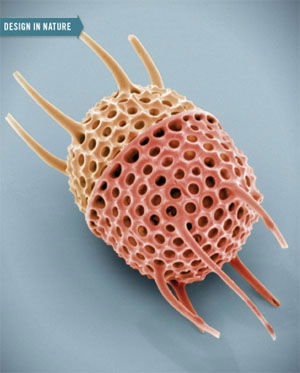Diatoms—Living in Glass Houses
Mankind was not the first to invent glass. Since creation, untold trillions of little creatures, called diatoms, have made their homes out of glass. Now we’re enlisting their help to engineer entirely new products for our benefit.
Countless tiny single-celled algae, called diatoms, thrive in seas, lakes, and moist soil all around the world. These creatures range in size from the finest dust up to a millimeter (about the thickness of a U.S. dime). More than 70,000 species have been catalogued as animals, plants, or something midway between.
Many diatom varieties house themselves inside intricate glass structures made of silica or silicon dioxide, the same composition as sand and glass. The microscopic, ornate diatom shells variously resemble chandeliers, cylinders, pillboxes, snowflakes, stars, and crowns. They are treasures of beauty on the smallest scale of creation.
Today materials scientists are looking at diatoms to provide them with ready-made components to put into miniature devices on a molecular scale (called nanotechnology).
The researchers fabricate small devices for use in electronics, medicine, and optics. Some diatoms have openings, or pores, that provide ready-made filters for chemical separation. Other diatom surfaces are covered with a regular array of glass bumps that can function as focusing lenses for optical computers.

Steve Gschmeissner | Photo Researchers, Inc.
Diatoms also provide components for micro-machines, such as motors, pumps, and valves. Because glass is fragile, specific diatom shapes are made more durable by heating at 1,652°F (900°C) for several hours in the presence of magnesium or titanium vapor. The silica glass vaporizes and is replaced, atom by atom, with tough metal ceramics in exactly the same shape.1
Researchers also hope to coax diatoms to grow into new useful shapes called “designer diatoms.” For example, diatoms could become capsules for delivering medicines to specific parts of the body. Success thus far is limited because we do not understand how diatoms sculpt their glass palaces, but research continues.2
Diatoms are said by evolutionists to have originated 180 million years ago, yet their fossils reveal the same intricate designs as living examples.3 In truth, they first appeared during Creation Week just thousands of years ago, and they have not improved over time. Instead, diatoms display master craftsmanship with unlimited potential applications.
Nature is filled with similar examples of planned usefulness. Long ago, Moses reminded Israel of its practical blessings, including “treasures hidden in the sand” (Deuteronomy 33:19). In our day, we continue to discover more about God’s blessings through creation, including diatoms made of sand.
Answers Magazine
October – December 2010
Human life is sacred, from conception until the day we die. This issue focuses on a creation-based understanding of the sanctity of life and mankind’s violation of the Creator’s clear directives. Feature articles explain when life truly begins, the shocking reality of human trafficking even in the West, and end-of-life decisions, such as living wills. Don’t miss this informative, edifying, and challenging issue!
Browse Issue SubscribeFootnotes
- Philip Cohen, “Natural Glass,” New Scientist 181, no. 2430 (2004):26–29.
- Alexandra Goho, “Diatom Menagerie,” Science News 116, no. 3 (2004):42–44.
- Jane Bradbury, “Nature’s Nanotechnologists: Unveiling the Secrets of Diatoms,” http://ncbi.nlm.nih.gov/pmc/articles/PMC521728/.
Recommended Resources

Answers in Genesis is an apologetics ministry, dedicated to helping Christians defend their faith and proclaim the good news of Jesus Christ.
- Customer Service 800.778.3390
- © 2024 Answers in Genesis





